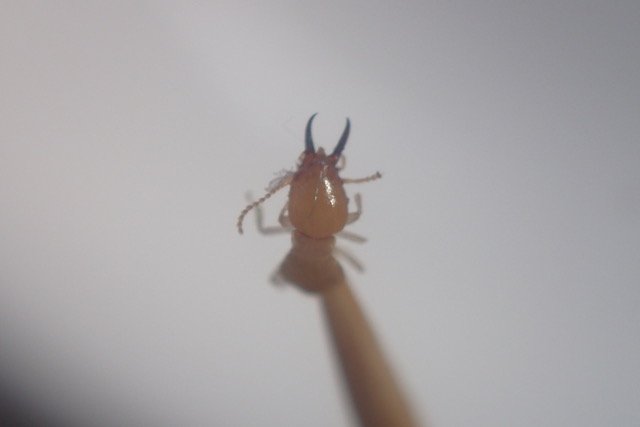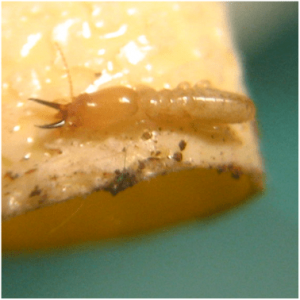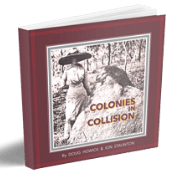Here’s How to Identify an Australian Termite
First off, take a breath… the best part is if you have discovered a ‘Termite’ a plan can now be made to get rid of them (from your house, shed, garden or tree). They don’t eat kilograms of timber a day, so there is time to identify what exact termite you have.
Here are Two Ways to Show Us Your Termite:
Termites (Also Called White Ants)
Subterranean termites are small, soft-bodied insects that build large nests in soil or trees and have underground tunnels that can reach up to 100 metres away from the nest.
Termites cannot survive in the open, they need 3 things to survive… Moisture, Food and Shelter
They are found in Australia and there are over 300 species of Australian termites but not all are a threat to homes.
Serious Termites
There are four main termites general we call serious pests of buildings
Because they all eat (prefer) solid timber —the seasoned stuff used in houses.
- Coptotermes or Coptos
- Schedorhinotermes or Schedos (pronounced Shed-o)
- Nasutitermes or Nasutes
- Mastotermes or Mastos
Coptos
Coptotermes
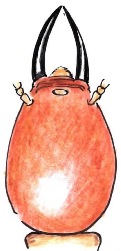
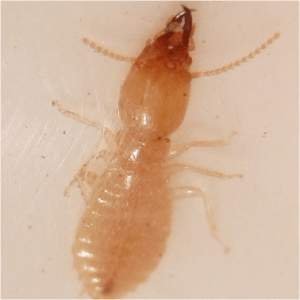

Schedos
Schedorhinotermes
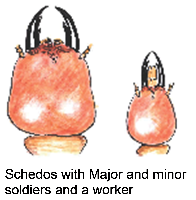
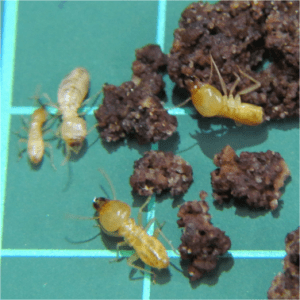
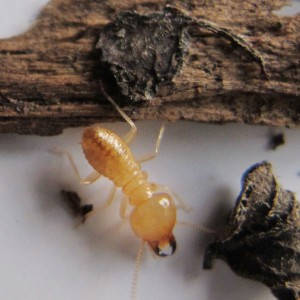
Soldier termites have brownish heads and two fang-like jaws sticking out in front. They measure 5-7mm.
They also have a fontanelle or hole at the top front of their heads to emit a white droplet of defensive goo.
So if
You live anywhere in continental Australia;
You’ve found termites eating solid wood;
They are about 5-7mm long with two black jaws
Your Termite is most likely to be either Coptos or Schedos.
Both termites are enticed to Termite Monitors and remain to feed for a long period due to the timber size.
And both termites are susceptible to the Colony Killer Termite Bait
There are a few species of each of Coptos and Schedos found in different regions, some with slightly different nesting habits, jump onto Live Chat if you have any questions
Nasutes
Nasutitermes
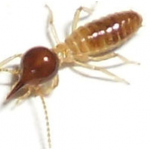
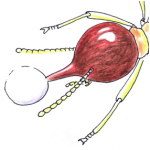
Easily identified by the pointy heads of their soldier.
Not many people enthuse a termite mound as a feature in their backyard so Nastutes suffer the consequences of being obvious —and they don’t rate in the serious pest category.
If these are the ones you’ve found, look around for a mound nest and physically destroy it with a pick, mattock or crowbar.
Mastos
Mastotermes

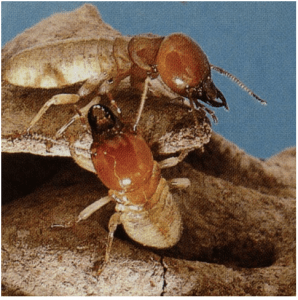
Rated very highly as serious —but only if you live north of the Tropic of Capricorn (Rockhampton to Exmouth).
Identification is also easy: if you live in this region and the termite you’ve found is about 13-15mm long (half an inch or so) and it is eating solid wood — it is a Masto.
While Mastos are certainly enticed by Termite Monitors and due to the timber size will feed for quite a while, Colony Killer Termite Bait is not recommended nor registered for use on Mastos.
If you’re in Mastro territory and can’t get Fipronil insecticide or a pestie to dose a Termite Monitor, you shouldn’t buy Termite Monitors.
So…The Not-So-Serious Termites?
We don’t recommend using our Colony Killer Termite Bait or Termite Monitors for any other termite
However, we will give advice.
The Nasutes (brown pointy heads, no black jaws) always build mounds. There are other mound builders that have black-jawed soldiers (often smaller than 5mm)
So if you’ve found some like these in garden mulch, fences or retaining walls, check for mounds to a radius of about 30-50 metres.
Some of the less serious termite species do not build mounds but nest below soil level or behind retaining walls.
Here is a Chart that May Help You ID the Termite You’ve Found
If you’d prefer to use our Free ID Service, you can take a photo and send it by email or SMS. You could get a same-day answer. Or you could catch some soldiers and post them and we’ll phone you

Serious (damaging) termite species
Copto
Found all around Australia. Avocado-shaped heads, and jaws without teeth, may emit white globules. About 7mm long although a couple of Copto species are smaller… about 4-5mm long.
Schedos
All around Australia. Major and minor soldiers, teeth on the inside base of jaws, may emit white globules, to 8mm in length
Mastos
North of the Tropic of Capricorn, no other termite in this region is as large at 13-15mm.
Nuisances (Non-Damaging) Termite Species
Heteros
All around Australia. Long cylindrical heads almost the same length as the body, no teeth on jaws, 3-5mm total length. Most noticeable feeding on the weathered surface of fences, decking etc
Microcerotermes
(Micros)
Represented by at least one species over all of Australia, some of which build a mound in the ground, atop posts, or on the side of trees.
Mostly leaf-litter and grass eaters but some will eat sound, decaying or weathered timber.
Dry Woods
(Cryptos)
Mostly found along the more tropical coast although Cryptotermes Austrinus is found in central Australia. Solider heads are almost vertical at the front with short broad jaws with teeth. They do not need contact with the soil for moisture. Small colonies; maybe in furniture, even picture frames or ornaments.
Others
There are even big ones that eat decaying timber, small ones that eat grass.
There are another 300 species we haven’t covered. You’d have to be pleased we decided not to confuse you with a full description of them all.
Send Your Actual Termite for us to Identify
Our Termite Identification Kit makes simple work of termite Identification and no guessing.
It’s as simple as grabbing a termite soldier (they are the ones with brown heads) and sending the termite to us for physical identification
Receiving the actual soldier allows us to identify the less common termites that might be
Take Some Photos of the Termites
Tell us a little about what you have found and attach a photo or video so that we can help identify the species of termite. Indicated on this page are some of the recent identifications we’ve undertaken.
Close-up photos of termite soldiers (brown heads) are the most helpful.
We particularly want to see the shape of their heads and their jaws in our identification process. We can enlarge your photos at our end so it is more important that your photo is in focus even if the insect appears relatively small.
You can easily pick up a soldier if you use a toothpick with a dab of Vaseline or any ointment on one end. Once captured, put the other end in a banana, mandarin or Blu-tac for photographing.
* You may be reluctant to add your phone number thinking you’ll receive sales calls from us. You won’t.
Adding your phone number simply allows us to call you if necessary to assist in the process of identification and more effectively advise you on what action is required (if any) in your situation.
